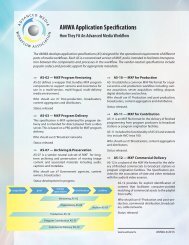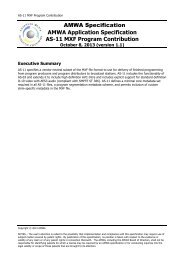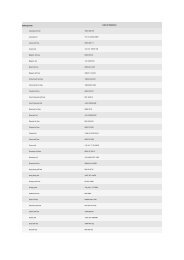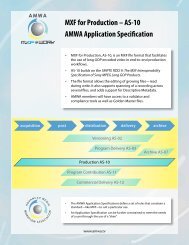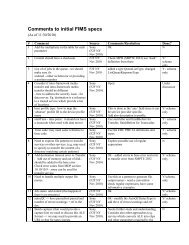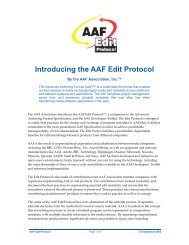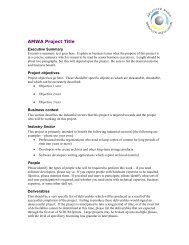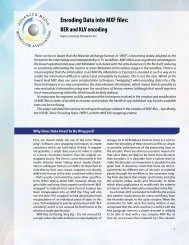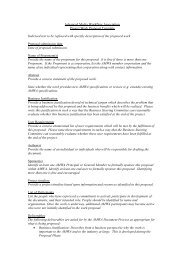<strong>FIMS</strong> <strong>Media</strong> <strong>SOA</strong> <strong>Framework</strong> Phase1 (Preliminary)9 <strong>Media</strong> Centric Features (informative for this edition)<strong>SOA</strong> has become an established approach for a range of IT systems such as information systems, accountingsystems, etc. However, in seeking to apply a <strong>SOA</strong> approach to a <strong>Media</strong> system, several unique media-centricissues also need to be considered. This section describes the specific <strong>Media</strong> centric features applicable to a<strong>Media</strong> <strong>SOA</strong> system.9.1 Composite ServiceA Composite <strong>Media</strong> Service is composed of more than one existing service in order to realize functions and/orperformance that use of individual existing services by themselves cannot achieve.Because there seems to be no other service than Capture (or Ingest) that requires tight service integration withpipelined processing, this section focuses on the Capture service, while the generic mechanisms needed todefine a composite service are left for future study.Capture provides a function that imports the AV essence from other AV systems to the media system,Transform is a function that transforms the properties of AV essence such as format, data size, and colorgrading, within the system, and Transfer is a function to move a media file from one place to another within thesystem.A workflow that receives AV essence from other AV systems, transforms it as appropriate and stores it in thesystem is usually called ‘Ingest’. While this would seem to be capable of being realized simply by invoking inturn the Capture service, the Transform service, and the Transfer service, for AV media there are several issuesthat need to be carefully considered. For example, AV process handling, the interface boundary between theCapture and the Transform services, and the issue of pipelined handling in order to optimize performance.Figure 3 shows a block diagram of typical Ingest system, where the video handling part is highlighted.In this diagram, the AV Process indicates baseband signal processing such as LUT (Look Up Table) based Colorgrading, QC (Quality Check), Cropping, Resizing, and Burn-in (text-overlay). The preferred order and/orconfiguration of such processes depend on the workflow, which needs to be flexibly tailored to meet the user’sspecific demands.One of the most important performance factors of Ingest is to minimize the delay between the Capture of AVessence and its readiness for use by downstream services. Movement of AV essence between internal blocks istherefore optimized. In addition, frame or GOP based pipelined processing is introduced (see Figure 4) tofurther reduce delay.FileSDIHD‐SDIBasebandFile CaptureFileUnwrap DecodeVTR/LiveCaptureBasebandAVProcessBasebandEncodeWrapTransferIngestFileFigure 3 Typical Ingest Process Block DiagramPrivate committee documentWorking Draft for review by <strong>FIMS</strong> Rev v1, Nov-16-2010 Page 72 of 89
<strong>FIMS</strong> <strong>Media</strong> <strong>SOA</strong> <strong>Framework</strong> Phase1 (Preliminary)IngestCapture12 3 4 5 6Transform12 3 4 5 6Transfer12 3 4 5 6Pipelined per frame (GOP)timeFigure 4 Pipeline ProcessFigure 5 shows a typical block diagram of Ingest composed of Capture, Transform and Transfer.The input for the Capture service includes file or SDI/HD-SDI from the live production system and/or theconventional VTR. Because SDI/HD-SDI is baseband signal, it is hard to move it as it is to the followingdownstream services. Hence, the Capture service in Figure 5 transforms the incoming baseband signal into aform of file, and passes it to the following service. In this case, problems occur not only due to the largeoverhead of data movement between services but also because of the highly duplicated functionality among theCapture and Transform services due to the former containing processes used in the latter.As shown in Figure 5, when the Capture service contains a Transform service, Ingest is realized without anadditional external Transform service. This also makes it possible to realize the optimized pipelined processingbetween the Capture and Transform services. Note, however, that even in this case, pipelined processingcannot be realized between Capture and Transfer services.FileSDIHD‐SDIFile Capture Unwrap DecodeVTR/LiveCaptureAVProcessEncodeWrapFileCaptureUnwrap Decode Encode WrapAVProcessFileTransformIngest 1TransferFilePrivate committee documentWorking Draft for review by <strong>FIMS</strong> Rev v1, Nov-16-2010 Page 73 of 89



